…where east meets west
- Home
- Brief History
- The Greenwich Meridian
- Greenwich
(1675–1958) - Herstmonceux
(1948–1990) - Cambridge
(1990–1998) - Outstations (1822–1971)…
- – Chingford (1822–1924)
- – Deal
(1864–1927) - – Abinger
(1923–1957) - – Bristol & Bradford on Avon
(1939–1948) - – Bath
(1939–1949) - – Hartland
(1955–1967) - – Cape of Good Hope
(1959–1971)
- Administration…
- – Funding
- – Governance
- – Inventories
- – Pay
- – Regulations
- – Royal Warrants
- Contemporary Accounts
- People
- Publications
- Science
- Technology
- Telescopes
- Chronometers
- Clocks & Time
- Board of Longitude
- Libraries & Archives
- Visit
- Search
Astronomical Regulators: Dent 1914, 1915, 1916, 2009, 2010, 2011, 2012, 2013, 2014, 2015, 2016 and 2017
page under construction
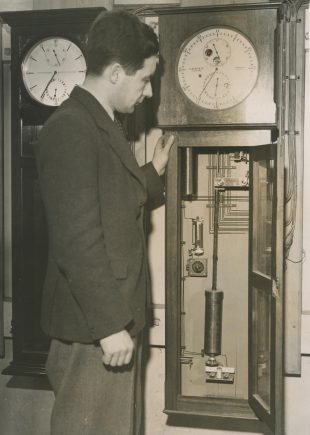
Dent 2012 is possibly the best known of the twelve Dent clocks. Following the addition of a zinc and steel pendulum and other alterations, it was adopted as the Observatory's Mean Solar Standard between 1893 and 1927. After further modification, it was used (along with Dent 2016) to transmit the BBC '6-pip' time-signals. It is seen here at Abinger, in about 1947, with the Head of the Time Department, Humphry Smith. Humphry Smith photographic archive
Ordered specifically for the expeditions by the Astronomer Royal on behalf of the British Government, the serial numbers of the twelve clocks were: 1914, 1915 & 1916 (all supplied with zinc and steel compensated pendulums), and 2009 to 2017 inclusive (all supplied with wooden rod pendulums). Although purchased for a common purpose, the twelve clocks subsequently had very different histories. All started life as sidereal clocks, but in later years many were adjusted to mean-solar time and three played a critical role generating time signals for the Greenwich Time Service.
After the Transit of Venus had occured, all the clocks were returned to Greenwich apart from Dent 1914 (which had been presented to the Khedive of Egypt for use in the Cairo Observatory). A couple of years later, ownership of the remaining eleven clocks was formally transferred from the Government to the Royal Observatory. Of those eleven, five are now in the care of the National Maritime Museum: (2009, 2010, 2011, 2012, 2016) and one is at the Cape Observatory (2013).
The historical importance of observing the Transits of Venus
Although the planet Venus passes between the Earth and the sun roughly every 584 days, when viewed from the Earth it normally passes either above or below the Sun. Just occasionally however, it passes directly between the Earth and the Sun, appearing as a small black dot against the Sun’s bright disc. These passages over the face of the Sun are known as transits and occur in pairs eight years apart. Each pair of transits is separated by more than a century. Since the telescope was invented in the early 1600s, just eight transits of Venus have occurred. They happened in the years:
1631 & 1639
1761 & 1769
1874 & 1882
2004 & 2012
During the 323 years that the Observatory existed, just four Transits occured. Their importance to astronomers in the eighteenth and nineteenth centuries was enormous, as they provided a rare opportunity to to measure the distance of the Earth from the Sun (the astronomical unit). To do this however, the Transits had to be observered from widely spaced locations and timed with great accuracy.
Part 1 – The 1874 and 1882 Transits of Venus
Priming the community
In 1857, the Astronomer Royal, George Airy, flagged up the forthcoming Transits of Venus to the fellows of the Royal Astronomical Society in a lecture titled On the Means which will be available for correcting the Measure of the Sun's Distance, in the next twenty five Years. In 1864, he presented a paper on the 1882 Transit and four years later, on 11 December 1868, almost six years to the day before the 1874 Transit, he presented a third, titled On the Preparatory Arrangements which will be necessary for efficient Observation of the Transits of Venus in the years 1874 and 1882.
In the introduction to Account of observations of the transit of Venus, 1874, December 8: made under the authority of the British government: and of the reduction of the observations, which was published in 1881, Airy described the next steps in his preparations for the Transit:
‘On 1869, February 15, I sent certain papers to the secretary of the Admiralty; on April 9 I wrote more formally with Estimate of Expense of Instruments; and on May 25 I sent a printed copy of the discussion of 1868, December 11, including also a paper by Mr. De La Rue on the application of Photography. About the same time an Estimate was furnished by the Hydrographer for expenses of travelling, residences, &c. [Each of these estimates proved ultimately much too small, the deficiency of my own being mainly in respect of observing-huts and general packages.] Approval to a certain extent was given by the Admiralty, and instrumental and other preparations were begun. Those transactions were reported to the House of Commons on July 6.’
The purchase of the clocks
Airy's 1869 Report (completed on 15 May), was the first to directly inform the Board of Visitors about the preparations he was making for the Transit:
'I have with much care and with the consumption of much time examined into the circumstances of the two transits, and have come to the conclusion, that after every reliance is placed on foreign and colonial observatories, it will be necessary for the British Government to undertake the equipment of five or six temporary stations. It is much to be desired that authority should. be promptly given for procuring the instruments which will be required.'
His 1870 Report informed them:
'The necessity of acting soon with reference to the Transit of Venus, 1874, was laid before the Government, who answered liberally to the appeal. With the funds placed at my disposal I purchased three 6-inch equatoreals, and have ordered two: I have also ordered altazimuths (with accurate vertical circles only), and clocks, sufficient, as I expect, to equip five stations.'
In 1871, he continued:
'My own time has been partly occupied in preparations for the Transit of Venus, 1874. I have taken measures for equipping each of five stations with a Transit, an Altazimuth, and an Equatoreal. Of transits I have five new, all mounted on stone piers. Of clocks to accompany them, I have two from the R. Observatory, three new. Of Altazimuths I have one from the R. Observatory, four new. Of Equatoreals, 6 inches in aperture, and carried by clock-work, I have five, purchased or new. Of clocks of an inferior class, to accompany the two last classes of instruments, I can supply only one, and must procure nine. Fifteen portable observatories must be prepared, of which I shall be able to exhibit specimens to the Visitors. The R. Observatory can supply three 4-inch detached telescopes, and two more will be desirable.'
The sole role of the transit telescopes was to establish the local time at the observing station from observations of the so-called clock stars. For this, a clock of the highest quality was recquired with a rate that was as near constant as possible as there was a real possibility that cloudy skies would prevent it from being checked against the clock stars for days or even weeks before the Transit of Venus took place. Airy ordered three new transit-clocks from Dent with zinc and steel compensated pendulums (Dent 1914, 1915 &1916). We know from the 13 February entry in Airy's Journal, that one of the Dents, possibly the first, was delivered to Greenwich on 9 & 10 February 1871 (RGO6/26/142).
Unlike the transit-clocks the nine clocks of 'inferior class' did not need to be such excellent timekeepers as they were regularly checked against the transit-clocks and could easily be checked against them at critical moments during the Transit of Venus. On this basis, Airy specified that they should be supplied with cheaper wooden rod pendulums with no form of temperature compensation. Having been ordered much later, they were delivered to Greenwich roughly 18 months after the three transit-clocks. Six of the nine were delivered while Airy was absent from the Observatory in September 1872 – Dents 2016 & 2017 on 5 September, Dents 2014 & 2015 on 12 September, and Dents 2012 & 2013 on 13 September (RGO6/784). It seems probable that the other three clocks Dent 2009, 2010 & 2012 were delivered soon after.
The transit clocks required a very stable mounting. In the published accounts, they are all described as being mounted on tripods. For example, Dent 1916, which was sent to Honolulu is described as being 'mounted on a massive tripod of mahogany and iron, which rested upon three stakes driven 2 or 3 feet into the ground'. By contrast, the 'inferior' clocks were attached to a single baulk of wood driven into the ground (images below).
As well as having a different type of pendulum to the 'inferior' Dents, Dents 1914, 1915 & 1916 also differed in their physical appearance, as can be seen in the images below, having:
- different door openings
- different dials – the winding aperture, lettering and the hour and minute dials all having slightly different locations
An examination of the dial of Dent 2010 by the National Maritime Museum indicates that the nine 'inferior' clocks had a brass dial, 288mm in diameter and painted off-white, together with a winding aperture located 63mm from the centre of the dial in the 42-minute position. As originally supplied, the 'inferior' clocks appear to have been conventional week-going (8-day), weight-driven regulators with dead-beat escapements and steel pallets.
The three transit clocks also seem to have been week-going as Dent 1916 was wound every Sunday at noon while in Honolulu (Account).
Prior to being set up in their observing huts at Greenwich for training the observers prior to their departure, the clocks all appear to have been stored on a specially made frame in the room located on the ground floor of the Great Equatorial Building, (which was one of the rooms allocated to the Time Department). It was here that the head of Department, William Ellis saw for himself, for the first time, how clocks mounted in close proximity influenced each others performance. He reported his findings to the Royal Astronomical Society in the following paper: On sympathetic influence between clocks.
The distribution of clocks amongst the 1874 expeditions
The British Transit of Venus expeditions were sent to five different locations across the globe. Designated stations A to E, their locations were as follows:
Station A – Egypt
Station B – Hawaiian (Sandwich) Islands
Station C – Rodriguez Island
Station D – New Zealand
Station E – Kerguelen Island
Seventeen clocks were sent in total to the five stations. All were regulated to sidereal time. Seven were used as Transit Clocks, five were used with the altazimuth telescope and five with the main equatorial telescope. The seventeen clocks consisted of:
- the twelve Dents
- four clocks lent by the Royal Observatory (Earnshaw, Graham 2, Arnold 2 & Molyneux) and
- one clock, Baker, which was borrowed from (via?) the Royal Astronomical Society.
The following clocks were sent to each station, stations B and E each having a sub-station which required the use of a second transit telescope (RGO59/58/1):
Station |
A |
B |
C |
D |
E |
||||||
| Transit Clock (s) |
Dent 1914 | Dent 1916 | Graham 2* | Arnold 2* | Dent 1915 | ||||||
| Earnshaw* | Baker | ||||||||||
| Eq. Clock |
Dent 2009 |
Dent 2012 |
Molyneux |
Dent 2017 |
Dent 2011 |
||||||
| Altaz. Clock | Dent 2015 | Dent 2013** | Dent 2014 | Dent 2016** | Dent 2010** |
* Pendlums upgraded to zinc and steel compensated ones for the expedition
** These three clocks are not mentioned by name in the reports of the expeditions that were later published. Apart from the Transit Clocks, RGO59/58 gives only the station that the other clocks were sent to, not the instrument that were assigned to be used with.
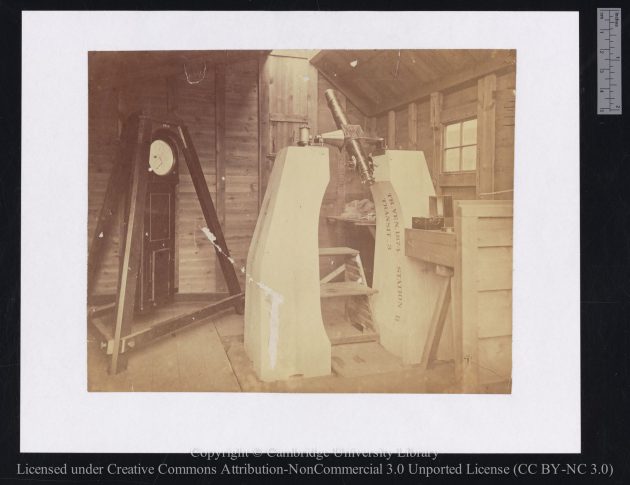
Dent 1916 with Transit Telescope B at Greenwich during training prior to being dispatched to Honolulu. Note the number 1916 stenciled on the tripod above the clock. Note also, the slightly ajar door below the dial in the lower half of the trunk. The photo was subsequently reproduced as a woodcut by Norman Lockyer in his book Stargazing: Past and Present (1878). Reproduced under the terms of a Creative Commons Attribution-Non-Commercial 3.0 Unported License (CC BY-NC 3.0) courtesy of Cambridge Digital Library (see below)
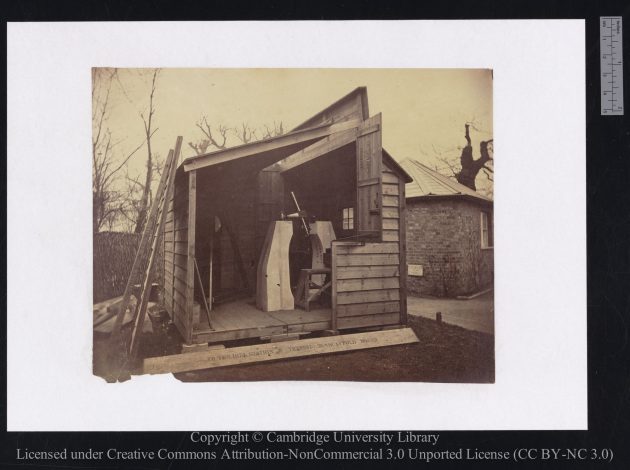
Taken from slightly further away, the photo shows the setting of the hut next to the building originally known as the office of the Clerk of works but later as the office of the Foreman of Works (demolished in about 1899). It also shows that in order to take the internal shots, one side of the hut had to be removed. Reproduced under the terms of a Creative Commons Attribution-Non-Commercial 3.0 Unported License (CC BY-NC 3.0) courtesy of Cambridge Digital Library (see below)
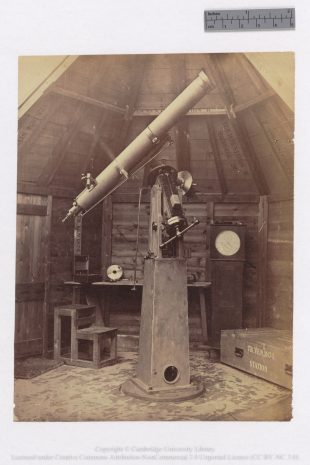
One of the 'inferior' Dents with one of the two Simms Equatorial Telescopes in the hut marked Station B at Greenwich. The serial number (on the dial) can't be sufficiently resolved to identify which of the Dents it is. The telescope and clock actually sent to Station B were the Naylor and Dent 2012. Given that the telescope in the photo is not the Naylor, there is no guarantee that the clock in the photo is Dent 2012. The photo was reproduced as a woodcut, in the 27 June 1874 edition of The Graphic
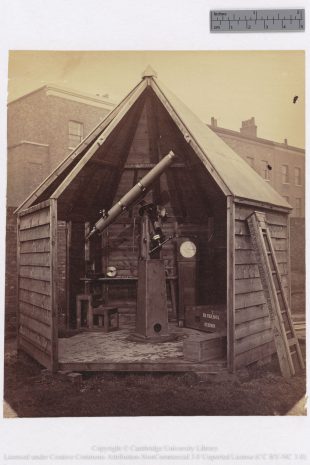
Taken from slightly further away, this photo shows the setting of the hut in the Reserve Ground in the north-east corner of Greenwich Park. The houses behind are in Park Vista. As above, one side of the hut has been removed for photographic purposes. The photo was published as a woodcut by Forbes in his book The Transit of Venus (1874). The two images are reproduced under the terms of a Creative Commons Attribution-Non-Commercial 3.0 Unported License (CC BY-NC 3.0) courtesy of Cambridge Digital Library (see below)
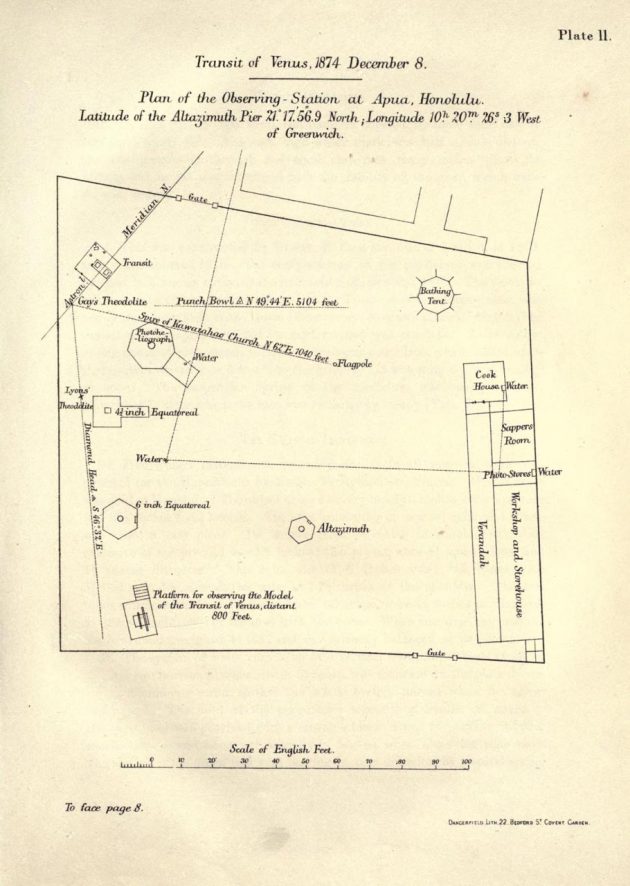
Plan of the observing site at Honolulu. Note the location of Dent 1916 and its stand in the corner of the transit hut and of Dent 2012 & 2013 in the Equatorial and Altazimuth huts. From: Account of observations of the transit of Venus, 1874, December 8: made under the authority of the British government: and of the reduction of the observations, via Internet Archive
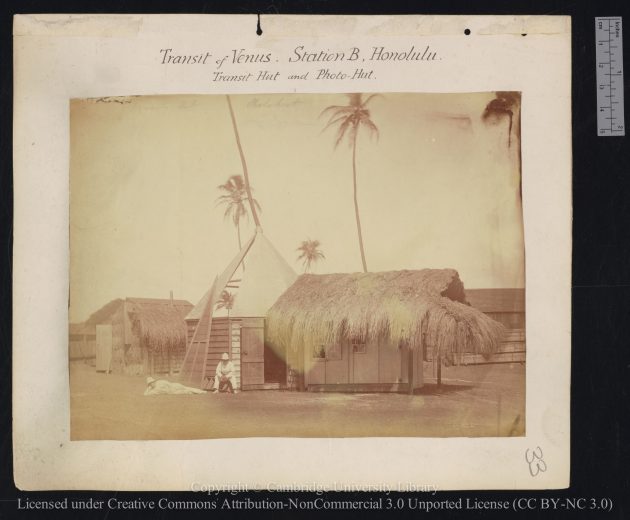
The transit hut (left) containing Dent 1916 at Honolulu. The hut to its right contained the photoheliograph (centre) and dark room (right). Note the palm leaves placed on the roofs of the transit hut and dark room as insulation. Reproduced under the terms of a Creative Commons Attribution-Non-Commercial 3.0 Unported License (CC BY-NC 3.0) courtesy of Cambridge Digital Library (see below)
The Cambridge Digital Library has also digitised two albums containing around 100 sheets of caricature drawings by Lieutenant Evelyn James Wheelock Noble that give a chronological record of the expedition to Station B (the Sandwich Islands). Included amongst the many drawings are several of the clocks as can be seen here and here for example.
The Life & Adventures of Station B, Album 1
The Life & Adventures of Station B, Album 2
The return of the clocks after the 1874 Transit
After the Transit of Venus, apart from Dent 1914, which was presented to the Khedive of Egypt by the expedition leader, Captain Orde Browne (though on whose authorisation is unclear), all the clocks were returned to Greenwich where they were stored on behalf of the Government. Their subsequent history prior to the 1882 Transit was as follows:
- Dent 2015 was used on 28/29 September 1875 when Observations of the lunar eclipse with made with the 2¼ inch altazimuth (assumed to be Altazimuth D, which was also known as ‘The Brass Beast’.
- On 25 April 1876, Dents 2009, 2015 & 2016 together with clock Earnshaw were sent to the South Kensington Museum for the loan exhibition of scientific instruments (for a period of a just over a year?).
- Between 2 June 1877 and 16 May 1878, all eleven of the Dents at Greenwich were formally transferred to the inventory of the Royal Observatory (ADM190/4/401–404).
- In May/June 1878 Dent 1915 was recorded as being in the East (Sheepshanks) Dome, whilst the remainder (Dents 1916, and 2009–2017) were recorded as being in store in the Lower Room of the South-east Dome (Great Equatorial Building) (RGO7/67, ADM190/4/402 & ADM190/3/251). They were later removed to the instrument shed (1879 Report).
Between the 1874 and 1882 Transits, Dent 1915 was the only one of the eleven Dents to be used at Greenwich in one of the telescope domes. It was used to time eclipses, occultations, and transits of Jupiter's satelites and occultations of stars by the Moon from observations made with the Sheepshanks Telescope. The First recorded observation using Dent 1915 was made on 20 June 1877. The last observation was made on 19 November 1880. Ten days later, on 29 November, it was dismounted in preparation for being shipped to the Cape, where it was being sent on loan. It was replaced the same day by Clock Earnshaw, which had been in the dome until it was removed in 1873/4 for the Transit of Venus expeditions (Greenwich Observations 1880). During the absence of Earnshaw and prior to Dent 1915 being installed in the dome, Arnold 1 had been used as a substitute.
A tantalizing image exists of one of the 'inferior' Dents in one of the photoheliograph huts, though when and where it was taken cannot be confirmed (click here to view). On the Science Museum website it is objecct number 1876-1006 and is credited to the School of Military Engineering at Chatham who according to the 1877 Report of the Astronomer Royal were lent a photoheliograph, though no loan of a clock was mentioned.
The 1882 Transit of Venus
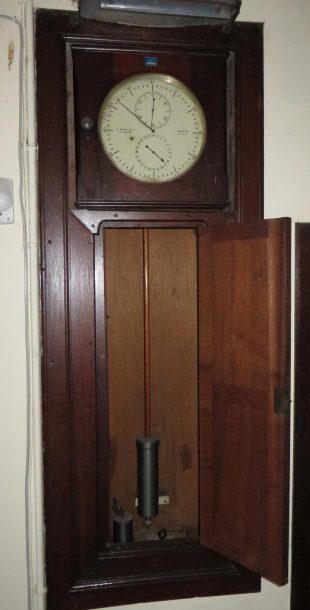
Dent 2013 at the Cape in 2022 where it is built in to the wall of the McClean Dome. See below for more information on its pendulum. Photo courtesy of Ian Glass
The Royal observatory lent at least thirteen and possibly as many as fifteen clocks for the 1882 expeditions. They were:
- The 11 Dent clocks originally purchased for the 1874 Transit of Venus,
- Arnold 2 and Graham 2,
- And possibly Molyneux and Arnold 3.
A letter signed by Thomas Lewis in the archives (RGO6/283/615) states that Dent collected the movements of twelve clocks from the Observatory on 24 January 1882 'for the purpose of fitting them for use in the Transit of Venus 1882'. They were listed as Dent 2009, 2010, 2011, 2012 (from the Magnetic Basement), 2014, 2015, 2016 & 2017, Molyneux, Arnold 2 & Graham 2 (which were marked best clocks) and Arnold 3. By this point, according to the ARs 1881 Report, three Dents were already at the Cape (Dents 1915, 1916 & 2013).
Prior to being sent on the Expeditions, five or possibly six of the Dents with the wooden rod pendulums had their pendulums upgraded to ones zinc and steel compensated ones. (Did they also have their steel pallets upgraded to jewelled ones?)
The Introduction to the 1890 volume of Greenwich Observations (but not the earlier volumes or later ones), gives the following details of the nine Dent clocks that remained on the inventory:
There were six with zinc and steel pendulums:
Dent 1916, 2010, 2011, 2012, 2016, 2017
and three with wooden rod pendulums:
Dent 2009, 2013, 2014
It has not yet been possible to establish if Dent 2015 had also had its wooden rod pendulum upgraded:
The locations that Dent 2007, 2008, 2009, 2012, 2014, Molyneux? and Arnold 3? were sent to requires futher investigation. The remainder were sent to the following locations
Station |
Clocks* |
|
| Jamaica | Dent 2010 & 2011, 1 wooden clock stand | |
| Madagascar | Dent 1915, 1 wooden clock stand | |
| Barbados | Dent 2016 & 2017 | |
| Wellington | Arnold 2, Graham 2, 1 clock stand | |
| Cape (for Montagu Road? or Aberdeen Road?) |
Dent 1916 & 2013 | |
| Durban | ? | |
| Brisbane | ? | |
| Bermuda | Dent 2015 |
*Locations based primarily on RGO6/283/461 which lists loan equipment returned form Jamaica, Madagascar, Brabados and Wellington between 30 January and 6 April 1883.
Two of the Dents, Dent 2015 and Dent 1915, did not return from the expeditions, leaving the Royal Observatory with just nine of the original twelve. Dent 2015 was lost at sea during fog on its return journey from Bermuda when the S.S. City of Brussels (on which it was being carried) collided and sank as it entered the River Mersey on its way to the Liverpool Docks. Dent 1915 was left at Durban on its way back from Madagascar, for use as a transit-clock at the Natal Observatory, by the expedition leader, the Rev. Perry, as he explained in this published extract from one of his letters:
‘The time at the Cape was telegraphed by Dr. Gill to Simon's Bay, and he has also sent us time signals at Durban, where Mr. Pett, on our outward trip, And Mr. Neison, F. R. A. S., on our return, have been of great assistance. Mr. Neison has just accepted the post of Director of the new Government Observatory at Natal, and is already in possession of a good 8-inch equatorial, by GRUBB. I am leaving our sidereal clock, Dent , 1915, for this observatory.’
Given that the rest of the equipment used at Madagascar that had been loaned by the Royal Observatory arrived back at Greenwich on 31 January 1883, Dent 1915 was probably left with Neison in December 1882. A letter dated 24 June 1884, was subsequently sent from Ewan MacGregor at the Admiralty to Christie, 'to signify to you their [Lordships] apporval of the sale, by the Secretary of the Transit of Venus Committee to the Natal Observatory for the sum of £75, of one of the clocks lent to the Committee, from the Royal Observatory Greenwich.’ (RGO6/283/706)
Part 2 – the clocks from 1882 onwards
First there were nine and then there were five – the long term loan of four of the clocks in the 1880s
By the mid 1880s, just five of the Dent clocks remained at the Observatory. They were Dent 2009*, 2012, 2014*, 2016 & 2017, the remaining four being on loan to other institutions. Those on loan were:
Dent |
Destination |
Details |
|
| 1906 | Cape Observatory | Loaned 1881, returned 1971 (Howse 1975) | |
| 2010 | Devonport | For timeball: adapted for purpose 1885, operational from 22 November 1886, transferred to Devonport on permanent charge 10 June 1912 (RGO39/4/60) | |
| 2011 | Kew Observatory | Loaned 1884/5, permanently transferred to the Air Ministry in exchange for magnetic apparatus of equivalent value in during 1925/6 reporting year, acquired by National Maritime Museum 1974 | |
| 2013 | Cape Observatory |
Loaned 1881 and never returned. Installed temporarily as the Transit Clock in 1888, replacing a clock by Hardy which had never performed well. Gill records that by 1888 it had been fitted with a zinc and iron [steel] pendulum, though as far as Greenwich was concerned it still had on of wood. The clock is still at the the Cape (2023) and appears to have had a wooden pendulum refitted |
The use of the Dents in the telescope domes at Greenwich
Of the five Dents that were left at Greenwich, three were put to use at some point in one of the telescope domes or pavilions and one was used for a while by the solar department. The fifth, Dent 2012 took on a different role (see next section).
Dent |
Details |
|
| 2009 | Placed in Great Equatorial Dome on 6 July 1894 (still with wooden pendulum) -(intro) not mentioned in earlier intro's | |
| 2014 | Mounted in South wing of New Phyical Building on 6 July 1894 for use by the Solar Department |
|
| 2016 | Modified for longitude operations in 1891 and moved into Transit Pavillion. Fitted with contact springs and taken to Waterville (Ireleand) on 11 April 1892 and placed in the Artificial Cable Room at the Telegraph Station in connection with longitude operations. Returned to Greenwich and moved to Lassell Dome by 1893 when it appears in the new inventory (RGO39/10/77). Removed from Lassell Dome on 25 October 1894 and placed in store in Lower Chronometer Room. To Thompson Dome by 1899 (probably 1898 as it was used as the controlling clock (sidereal time), Graham 2 was seemingly also there as a sidereal clock though some discrepencies in 1893 inventory (p.39 and p.132). | |
| 2017 | Mounted in Astrographic Dome, 14 March 1891 |
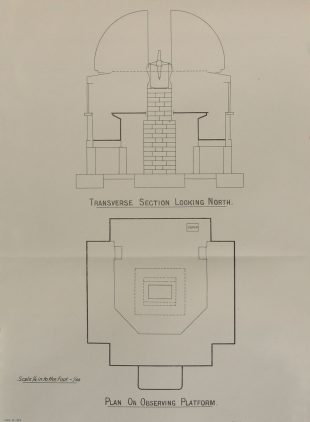
Section and plan of the Transit Pavilion. Note the location of the clock on the north side. Cropped from Plate IV from Telegraphic determinations of longitude made in the years 1888 to 1902, HMSO (1906)
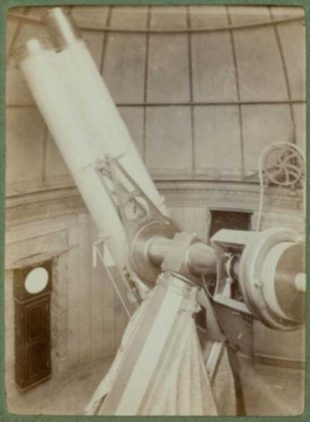
Dent 2017, alongside the Astrographic Telescope in the Astrographic Dome in about 1900. Reproduced under the terms of a Creative Commons Attribution-NonCommercial (CC BY-NC) licence courtesy of whatsthatpicture (see below)
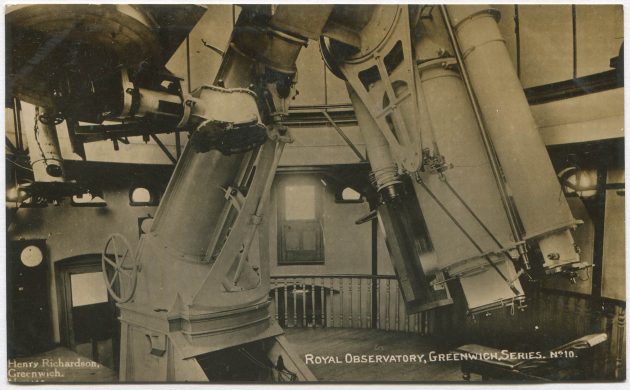
Dent 2016 (left), in the Thompson Dome in the New Physical Building. Note the large hole in the dial (top centre) made during the 1891 alterations (a further three holes were added later). Postcard published by Henry Richardson, in around 1908
Upgrading of Dent 2012 and its adoption as the mean solar standard
In 1884, William Christie informed the Visitors of problems that had been occuring with the Observatory's Mean Solar standard (the Shepherd Master Clock, which was responsible for sending time signals to other places in the Observatory and elsewhere in the country through the telegraph system) and the steps he had taken to deal with it. This included adapting Dent 2012 as the mean solar reserve. In his 1884 Report to the Board of Visitors he wrote:
‘The mean solar clock, made many years ago by Shepherd and Son, has on several occasions in the past year stopped through failure in the electric contact made by the pendulum. Mr. Shepherd has proposed an improved form of electric escapement, which he has fitted to a pendulum to be placed here for experiment within the next week. Meanwhile, in order to avoid the inconvenience caused by the stopping of the mean solar clock, which sends out the hourly time-signals to the Post Office for general distribution, one of the Transit of Venus clocks (Dent 2012) has been fitted by Messrs. E. Dent and Co., with the requisite contact springs, so that it can be used at any time in place of the electric mean solar clock, and a relay adapted for driving the sympathetic clocks by means of the clock Dent 2012 is being made.’
Having been converted, Dent 2012 was placed alongside the Shepherd Clock in the 'Ball lobby' which occupied the original outer entrance hall to Flamsteed House at the foot of the stairs to the Octagon Room (Introduction to the 1884 volume of Grenwich Observations).
In 1893, Dent 2012 underwent further alterations and was adopted as the mean solar standard. This was reported in both the Introduction to the 1894 volume of Greenwich Observations and the 1894 Report:
‘The adaptation of the mean solar clock Dent 2012, with zinc and steel pendulum, to send out the hourly signals and work the sympathetic dials by reverse currents at the alternate seconds, was completed by Mr. Kullberg on 1893 May 21, and from that date all signals were sent by this clock instead of by the electrical mean solar clock Shepherd. The clock worked satisfactorily till 1894 Jan. 20, when the contacts began to fail, and as it could not be relied on to drive the Observatory sympathetic dials satisfactorily, the clock Shepherd was generally used from that date till May 4, when a new set of contacts was applied to Dent 2012, and since then it has worked the sympathetic dials and sent out the hourly signals satisfactorily. Advantage was taken of the break to arrange for substituting the clock Dent 2012 for Shepherd, or vice versâ without loss of time.’
Dent 2012 remained the mean solar standard until superceeded by Shortt 16 in 1927.
Maunder and the spread of false information
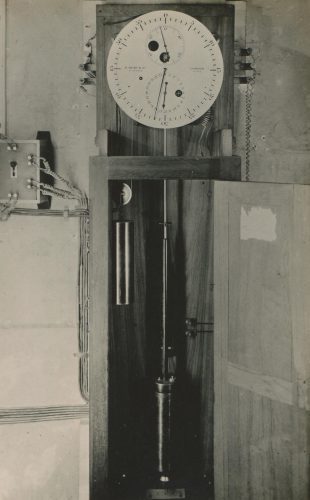
Dent 2012 in the Clock Room with its door open and hood removed. The clock appears to be mounted on the Quadrant Wall and was probably photographed no later than the early 1920s, when the Room had relatively few clocks in it (see below). The word Westminster appears to be written above the black knob of the switch to the left of the dial. Undated photograph, Humphry Smith photographic archive
The creation of a Clock Room in 1911
When William Christie retired in 1910, he was replaced as Astronomer Royal by Frank Dyson, his former Chief Assistant. and more recently, Astronomer Royal for Scotland. One of Dyson’s early acts was to create, for the first time at the Observatory, a thermostatically controlled Clock Room. He did this by converting Airy’s fire-proof Safe Room at the western end of the Meridian Building – a room created by Airy in 1839 that was bounded to the east by Halley’s Quadrant Wall and to the west by the external wall of the building. During conversion to the Clock Room, a second wall was built separated from the outside walls to the West and South by an air space, and double doors provided. It is estimated that it was about six feet wide and twelve feet long. The necessary extensions and alterations of the electric cables were carried out by the Engineering Department of the General Post Office during the latter part of October and early part of November 1911. The first two clocks to be mounted there were the Sidereal Standard, Dent 1906 and Mean Solar Standard Dent 2012, which was dismounted from the Ball Lobby on November 13, cleaned by E. Dent & Co. at the Royal Observatory, re-erected in the new Clock Room and brought into use again on November 14. In 1913/14, the Mean Solar Clocks, Shepherd and Graham 3, were also moved from the Ball Lobby into the Clock Room. As the years went by several new clocks were added and several older ones removed.
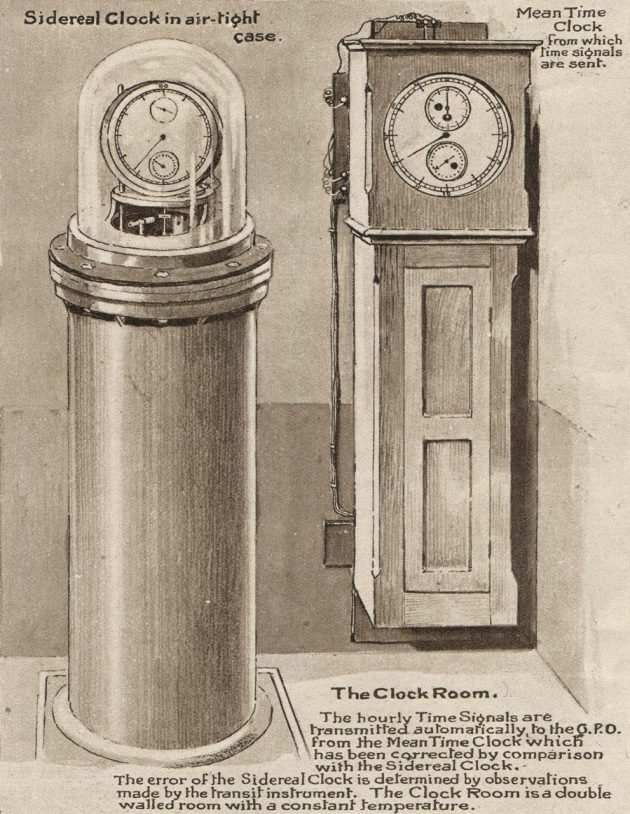
Dent 2012 right with the sidereal standard made by Cottingham to its left. In reality, the Cottingham is believed to have been wall mounted and both clocks are believed to have been housed in different positions to those shown. Drawn by W.B.Robinson, probably from photographs, the inscriptions on the two dials have been omitted. The image formed part of a double page spread of seven images published as part of an article by the Head of the Time Department, William Witchell, titled How Greenwich Time is obtained that was published by The Illustrated London News on 21 April 1923
The sidereal standard rarely showed the correct time, the true time being found by calculating the size of the correction that needed to be applied from the known rate of the clock. The mean solar standard on the other hand needed to be adjusted on a regular basis to show as accurately as possible what the true time was. In the article that accompanied the image above, Witchell explained how this was done:
'In comparing the clocks, advantage is taken of the fact that, as the one clock [the sidereal] gains on the other about a second every six minutes, the two clocks will be beating in unison for a few moments at six-minute intervals. The theoretical times at which this ought to take place can be computed beforehand; and if, for instance, the beat-coincidences are found to be occurring one minute late, the deduction is that the mean solar clock is one sixth of a second slow.'
What he failed to explain, was how Dent 2012 was briefly speeded up or slowed down to bring it to the correct time. We know that with the Shepherd this was done with electromagnets. Llikewise with Dent 2016 after it had been converted (image below). However, no such magnets can be seen in the photograph (above) of Dent 2012 in the Clock Room. The reasons for this still need to be explored.
Image: George Rickett of the Time Department at the Time Desk in the Meridian Building from where various clocks were checked and the Mean Solar standard adjusted
Image: Schematic diagram from Witchell's article showing the function of each component on the time desk
The adaption of Dents 2012 and 2016 to produce the 'six pip' time-signal transmitted by the BBCand the replacement of Dent 2012 as the mean solar standard
As was noted above, Dent 2016, was upgraded in 1891 by being fitted with contact springs for use in longitude operations. It was subsequently relocated (via Waterville) from the Transit Pavilion in the Courtyard to the Thompson Dome in the New Physical Building. It was upgraded again during the reporting year 1921/22 when it was 'f'itted with contact springs and correcting apparatus for use as a duplicate controlling clock for mean time circuits' – orders for the necessary work having been submitted on 22 July 1921 and 21 March 1922 (RGO39/4/60). It was probably at this point that it was moved into the Clock Room. It was upgraded again in 1923/24 when it was 'fitted with suitable control switches for the transmission of time signals to the British Broadcasting Company' – orders for the work having been submitted on 4 & 17 December 1923 (RGO39/4/60). Broadcasting of the 'six-dot' (later known as the 'six-pip') time signal by the BBC using Dent 2016 as the transmitting clock began on 5 February 1924, with signals being broadcast at 9.30 in the evening. However, due to advance printing, the first mention in the Radio Times that it came from Greenwich, didn't appear until the listing for Monday 18 February.
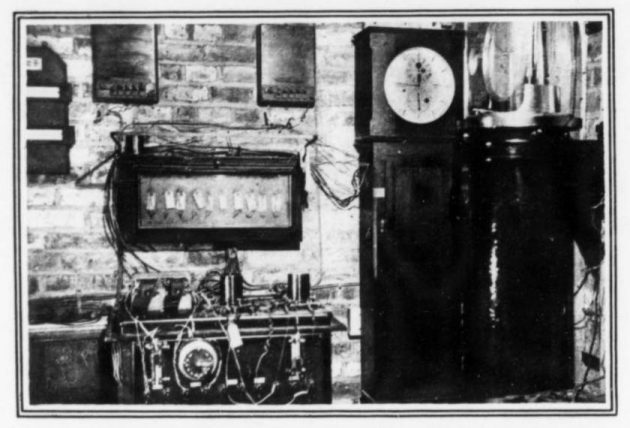
Dent 2016 (left) with the Cottingham Clock to its right. Photo by Topical. From the 23 February 1924 edition of The Illustrated London News (via Internet archive)
A few months after Dent 2016 had been converted, Dent 2012 (which had had its platinum contacts renewed in 1921 and it jewelled pallets reset in 1922) was also modified for the transmission of the 'six-pip' signals – the order for the necessary work having been submitted on 17 May 1924. In his 1925 Report, Dyson told the Visitors:
'The Mean Time Clock Dent 2012 has been fitted with suitable control switches for the transmission of time signals to the British Broadcasting Company. Thus both Mean Time Clocks are now available for this service. Signals can be sent to the Company's studio at 2, Savoy Hill, every half-hour, and are broadcast, usually twice during the afternoon and once during the evening.'
In 1927, December 1927, Dent 2012 lost its status as the Mean Solar Standard, having being superceed by the newly acquired clock Shortt 16, which amongst other things, was wired up to control the two Dents used for transmitting the six-pips.
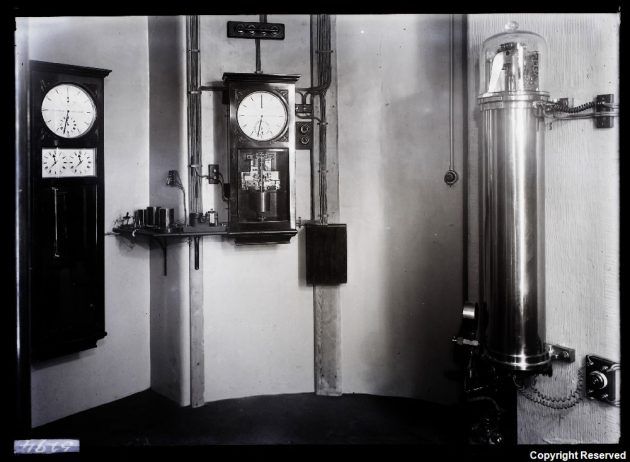
Shortt 16 was mounted in the newly created Rugby Room in at the end of October1927. It is seen here a few weeks later on 7 February 1928. The clock on the left is the slave clock of Shortt 16. It is mounted on the bricked up doorway leading to the North Terrace. The Shortt 16 master pendulum is on the right. It is mounted on the south side of the north pier supporting the Shuckburgh Telescope on the floor above. © BT Heritage. Reproduced under the terms of a Creative Commons Attribution-Non-Commercial-ShareAlike (CC BY-NC-SA) licence (see below). Image reference: TCB 417/E/5294
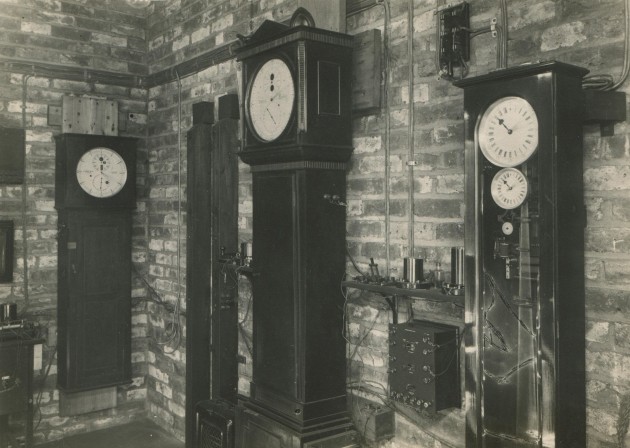
The Clock Room on 7 May 1928. From left to right, the three clocks are: Dent 2016, Dent 2 and the slave clock of Shortt 11. Humphry Smith photographic archive
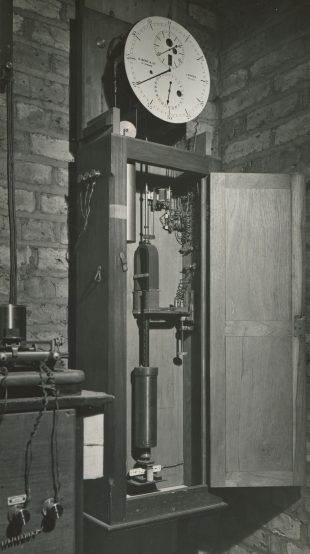
A BBC photograph of Dent 2016 taken in November 1937. It was captioned on the back: 'Regulator clock (showing interior) used for sending B.B.C "six dot" signals ... .' Humphry Smith photographic archive
Despite the fact that Dent 2012 was the main clock, it was always seems to have been Dent 2016 that was photographed by the press and interested parties such as the BBC and the Post Office (who for a while had been responsible for the wiring the various clocks together). It is surmised that this was to do with the cramped nature of the Clock Room. The 1926 inventory records that that year, there were eight clocks installed in the Room: Dent 2, Dent 1906, Dents 2012 & 2016, Riefler 50, Cottingham, and the slave clocks of Shortt 3 & 11 (RGO39/5). Dent 2016 was on the south wall opposite the entrance, whilst most if not all of the other clocks were facing each other on the two side walls. Given the narrow width of the Room, it was presumably impossible to photograph Dent 2012 and the other clocks except at a very obique angle.
The two photos nearby (right and below) are part of a set taken by the BBC in November 1937. Given that the one below provides evidence that Dent 2012 was the clock in service at the time, it raises the question as to why the captions are so potentially misleading. Was there a misunderstanding, or was the Observatory or the BBC being deliberately economical with the truth?
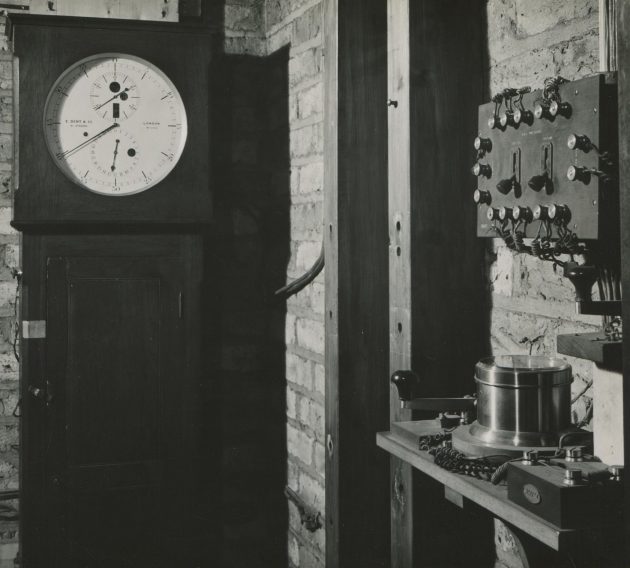
A second photograph of Dent 2016 taken by the BBC in November 1937. The caption on the back reads 'Another view of the Regulator Clock showing, on right, the relay apparatus used to pass on the time signal to Broadcasting House.' Humphry Smith photographic archive
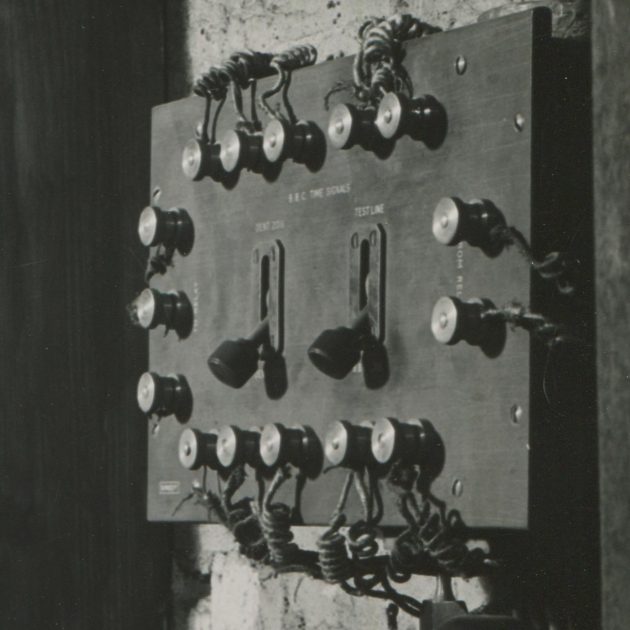
Detail from the image above showing that Dent 2012 rather than Dent 2016 was being used as the transmitting when the photo was taken. Humphry Smith photographic archive
Wartime – the setting up of reserve time-signal stations at Abinger
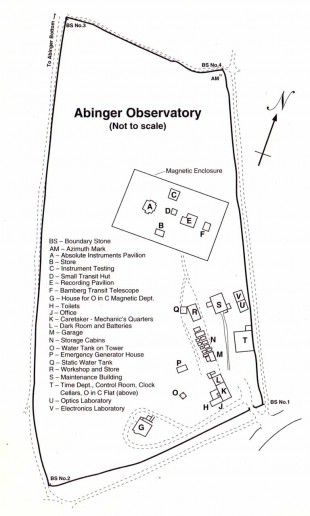
Post war plan of the Abinger site. The Shortt and Dent clocks of the Time Service were housed initially at location L and from 1942 until about 1950 in the specially constructed building marked S. S also housed the quartz clocks until a later new building T containing the clock cellars became available towards the end of 1944. Image courtesy of Peter Tarplee
'It has been decided to install at at the Abinger Magnetic Observatory the necessary apparatus for the maintenance of a subsidiary time service which could take over, whenever required, the more essential duties of time signal distribution normally carried out from Greenwich. The transit instrument D, which had been used in connection with the personal equation machine, has been mounted there, and pending the provision of additional equipment, the Dent clock formerly used as the sidereal standard clock at Greenwich [Dent 1906] and the mean time Dent regulator 2016, previously kept as reserve time signal transmitter, have been erected in the old battery room, which was cleared and partitioned to enable a reasonable temperature control to be maintained. Temporary chronograph equipment has also been installed.'
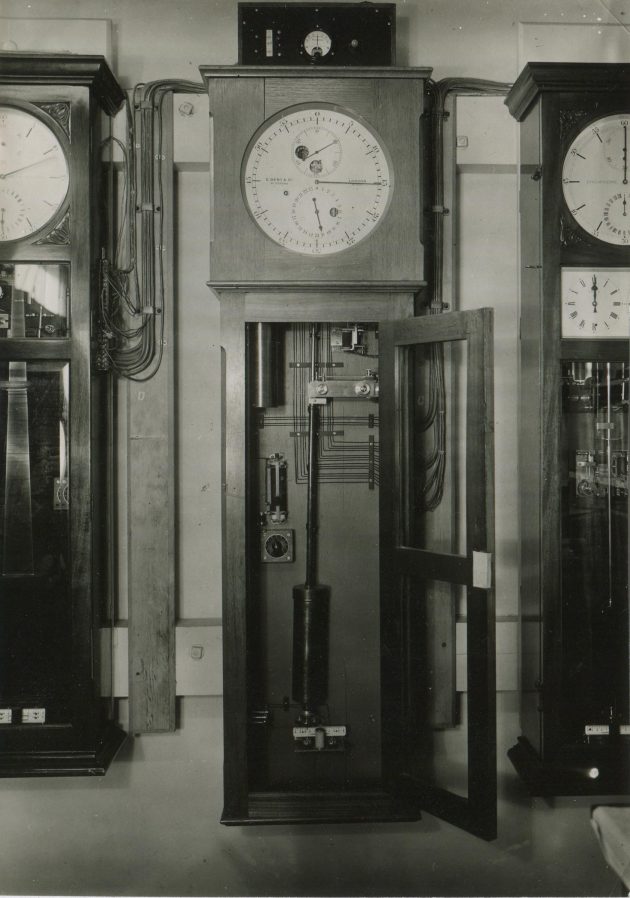
Dent 2012 in the outer of the two new clock chambers erected at Abinger in 1942 (building S in the plan above). Note the glazed door, which seems to have been installed while the clock was at Abinger. From left to right, the clocks are: slave of Shortt 49; Dent 2012; diminished seconds clock (stopped) of Shortt 67. Undated photo, Humphry Smith photographic archive
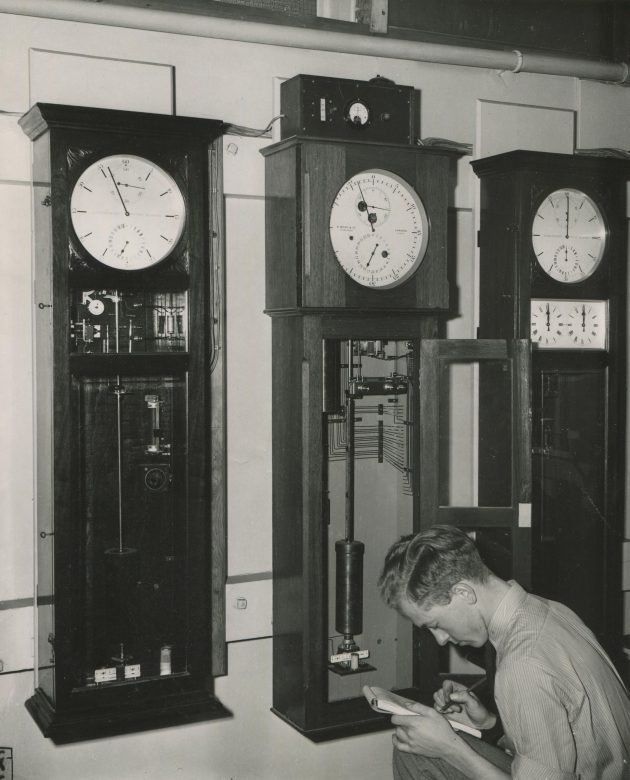
In this second view, more of the internal wiring on the hinge side of the clock can be seen. Thought to date from 1950, the picture features Assistant Experimental Officer, Peter Lamb. Humphry Smith photographic archive
Improving the provision at Abinger, the setting up a duplicates service at Edinburgh and the adaptiation of Dent 2009
Post war role of the Dents in the time service at Abinger and Greenwich
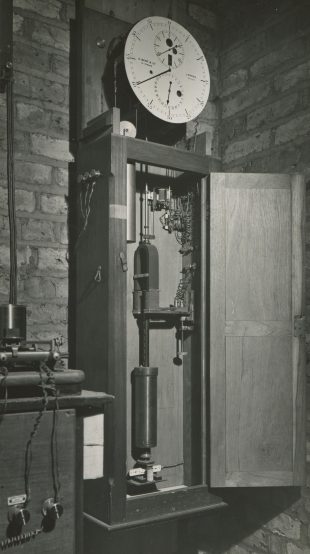
Pre-war photo of Dent 2016 taken in November 1937. Although reproduced earlier, it has been re-posted here to enable easy comparison with the post-war image (right). Note the absence of the horseshoe magnet and coils in the later image. Humphry Smith photographic archive
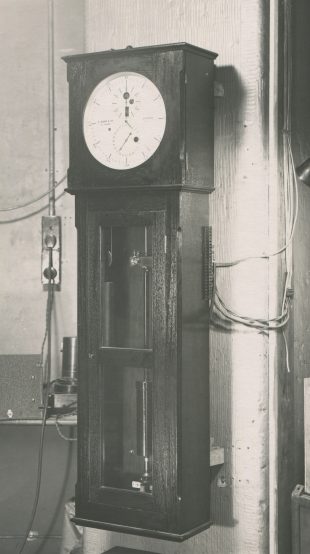
Post-war photo of Dent 2016 in the Rugby Room at Greenwich. It is not clear if the door was glazed when the clock was installed at Abinger, or when it was reinstalled at Greenwich. Undated photo (1946–1957). Humphry Smith photographic archive
Locations of the seven Dent Transit of Venus Clocks still owned by the Observatory in October 1948 and November 1954
By 1948, five of the original twelve Dent's were no longer on the books at Greenwich. As a reminder of their earlier history: Dent 1914 was presented to the Khedive of Egypt in 1872; Dent 1915 was sold to Natal Observatory in 1884, Dent 2010 was permanently transferred to Devonport in 1912; Dent 2011 was permanently transferred to Kew Observatory in 1925/26 and Dent 2015 was lost at sea in 1883.
The information about the remaining seven clocks given in the table below is based primarily on a report compiled by Roy Tucker in 1954 (RGO71/1/3/1).
| Dent 1916 | Still on loan to the Cape | |
| Dent 2009 | 1948: Case in Rugby Room at Greenwich, movement at chronometer workshop Herstmonceux. 1954: Case and pendulum in Rugby Room, movement in box in chronometer workshop Herstmonceux |
|
| Dent 2012 | 1948: clock going and transmitting BBC time clock under the control of Shortt 49, position 4, lower control room (ie clock room) at Abinger. 1954: stored in Cellar Corridor, Abinger |
|
| Dent 2013 | Still on loan to the Cape |
|
| Dent 2014 | In Thompson Dome at Greenwich until 1940 1948: Case in still in Dome, pendulum in outer clock cellar, Greenwich 1954: Pendulum in Rugby Room at Greenwich; movement in box in Chronometer Workshop, Herstmonceux |
|
| Dent 2016 | 1948: In the Rugby Room at Greenwich; going and transmitting BBC time signals under the control of Shortt 67 1954: As above |
|
| Dent 2017 | In Cookson Pavilion in Christie Enclosure at Greenwich until c.1940 1948: Pendulum in Outer Clock Cellar, Greenwich 1954: Pendulum in Rugby Room at Greenwich; movement in box in Chronometer Workshop, Herstmonceux |
Current locations of the original twelve clocks
Dent |
Location |
|
| 1914 | Presented to the Khedive of Egypt for use in the Cairo Observatory in 1874/5. No further information available | |
| 1915 | Sold to Natal Observatory 1884. No further information available | |
| 1916 | Loaned to the Cape Observatory in 1880/81. Returned to RGO 1971. Last recorded as being mounted in Herstmocneux Castle, west entrance, first floor (Howse 1975). No further information available | |
| 2009 | Now at National Maritime Museum (NMM) Object ID:ZAA0604 | |
| 2010 | Now at NMM Object ID:ZBA7932 | |
| 2011 | Now at NMM Object ID:ZAA0600 | |
| 2012 | Now at NMM Object ID:ZBA1292 | |
| 2013 | At the Cape Observatory since 1880/81 where it remains today |
|
| 2014 | At Herstmonceux 1954. Sent to Hartland 1960. No further information available | |
| 2015 | Lost at Sea, 3 January 1883 on return trip from 1882 Transit of Venus | |
| 2016 | Now at NMM Object ID:ZAA1293 | |
| 2017 | At Herstmonceux 1954. Sent to Hartland 1960. No further information available |
Further Reading
Stargazing: Past and Present. J. Norman Lockyer (1878)
A tale of two telescopes: North Queensland and the 1882 Transit of Venus. Wayne Orchiston (2017) (pdf)
Image licensing
The images reproduced courtesy of Cambridge Digital Library are more compressed than the originals and image 4 has had its side margins cropped. They have been reproduced under the terms of a Creative Commons Attribution-NonCommercial 3.0 Unported License. Links to the individual images are as follows: Image 1, Image 2. Image 3, Image 4, Image 5.
The clock Dent 2017 in the Astrographic Dome, c.1900 is reproduced under the terms of a Creative Commons Attribution-NonCommercial (CC BY-NC) licence courtesy of whatsthatpicture. For link to original image click here
The photograph marked © BT Heritage was obtained from The BT Digital Archives and is reproduced under the terms of a Creative Commons Attribution-Non-Commercial-ShareAlike (CC BY-NC-SA) licence. They are more compressed than the originals.
© 2014 – 2025 Graham Dolan
Except where indicated, all text and images are the copyright of Graham Dolan